JAVA introductory system tutorial (8) Object-oriented (inheritance)
1. The concept of inheritance: Inheritance is a relationship between classes. An "is a" relationship
Parent class--->Base class Subclass--->Derived class
Note: Inheritance in JAVA is single inheritance2. Advantages of inheritance: The subclass has all the properties and methods of the parent class (private modification is invalid) to achieve code reuse
##3 . Grammar rules: class subclass extends parent class
Example:
package example;
public class Animal {
public int age;
public String name;
public void eat() {
System.out.println("动物不吃东西就会饿");
}
}
package example;
public class Dog extends Animal{
}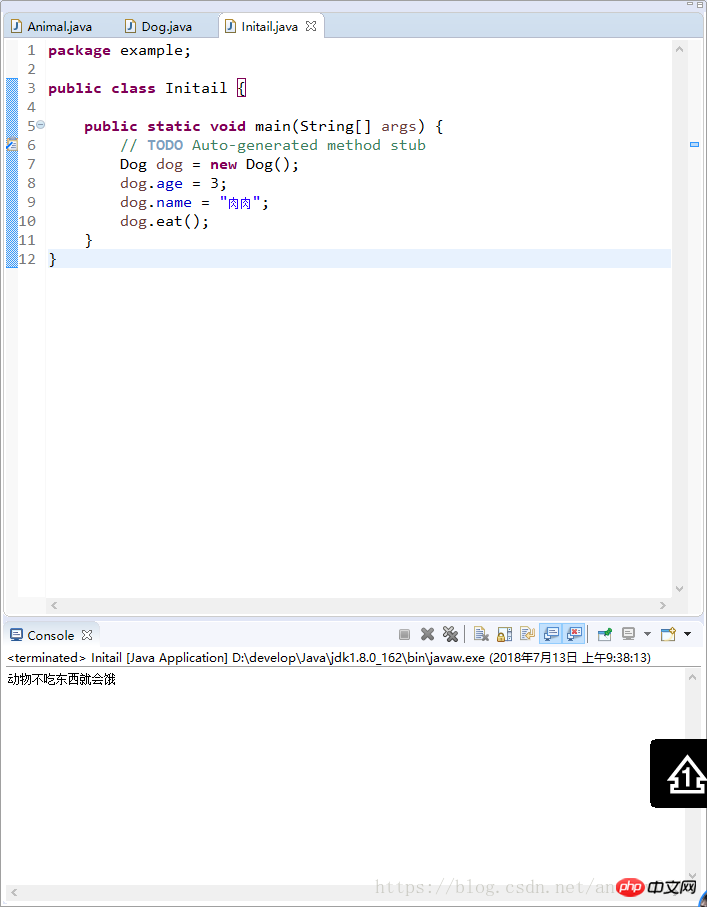
4. Rewriting of methods: If the subclass is not satisfied with the method inherited from the parent class, it can override the method inherited by the parent class. When calling the method, the method of the subclass will be called to a limited extent
package example;
public class Dog extends Animal{
public void eat() {
System.out.println("年龄:"+age+"\n狗狗不吃东西就会饿");
}
}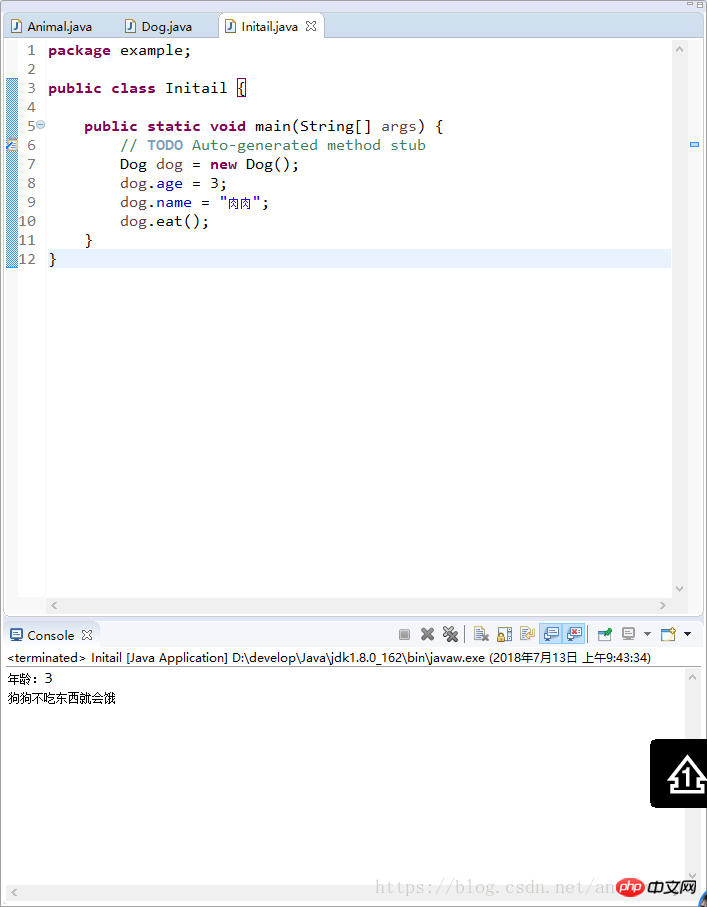
5. Initialization sequence in inheritance
package example;
public class Animal {
public int age;
public String name;
public void eat() {
System.out.println("年龄:"+age+"\n动物不吃东西就会饿");
}
public Animal() {
System.out.println("这是执行了Animal类");
}
}
package example;
public class Dog extends Animal{
public Dog() {
System.out.println("这是执行了Dog类");
}
} Another example:We first assign a value to age in the Animal class, and then assign it in the Animal method age is assigned again
Another example:We first assign a value to age in the Animal class, and then assign it in the Animal method age is assigned againpackage example;
public class Animal {
public int age = 10;
public String name;
public void eat() {
System.out.println("年龄:"+age+"\n动物不吃东西就会饿");
}
public Animal() {
System.out.println("这是执行了Animal类");
age = 20;
}
}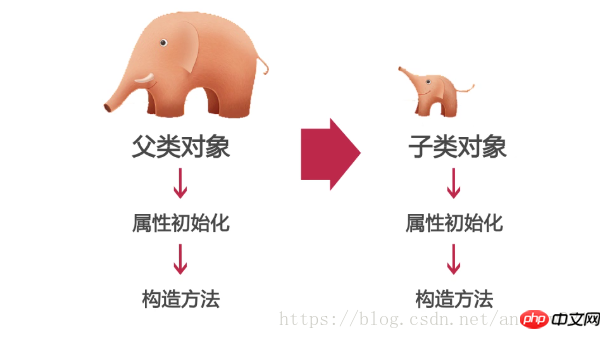
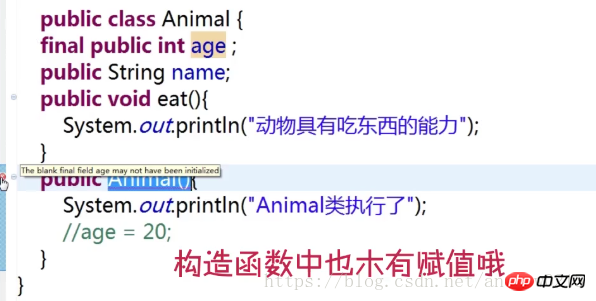
7. The use of super keyword: used inside the object, it can represent the parent class object
1) Access the attributes of the parent class: super.age
2) Access the method of the parent class: super.eat()
Example :
package example;
public class Dog extends Animal{
public Dog() {
System.out.println("这是执行了Dog类");
}
public void method() {
System.out.println(super.age);
super.eat();
}
}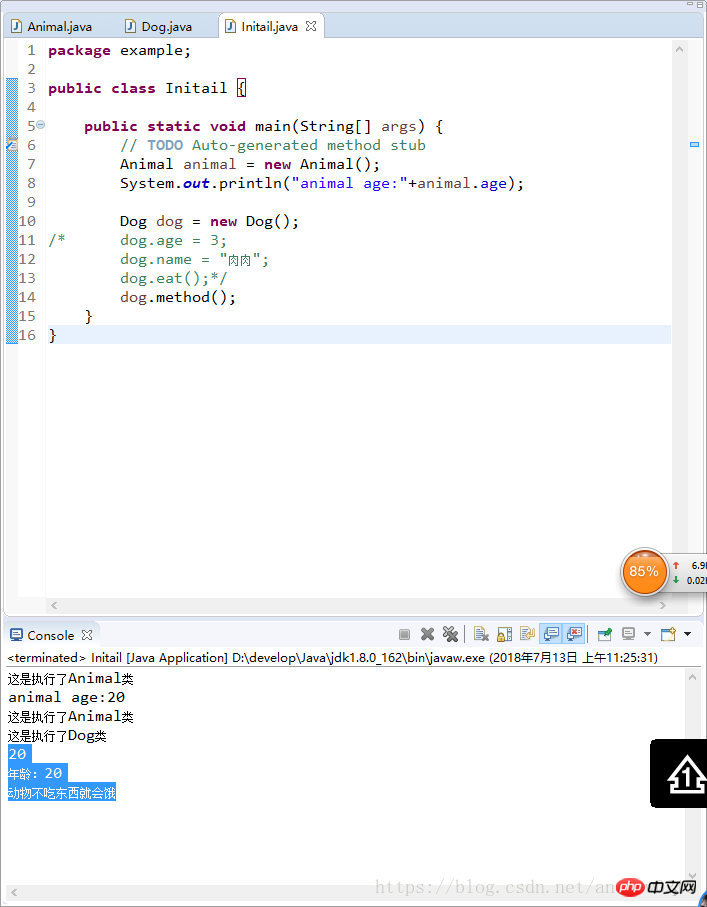
3) Application of super
Construction of subclasses The constructor of its parent class must be called during the method process.
public class Dog extends Animal{
public Dog() {
super(); //这里是显示的 写与不写是一样的 但写的话必须放在第一行
System.out.println("这是执行了Dog类");
}
public void method() {
System.out.println(super.age);
super.eat();
}
}
If the constructor of the subclass does not display the constructor of the parent class, the system will call the parent class's no-argument constructor by default
If the constructor is called explicitly, it must be in the first line of Zi Erlei's constructor.
If the constructor of the subclass does not explicitly call the constructor of the parent class, and the parent class does not have a parameterless constructor, a compilation error will occur
public class Animal {
public int age = 10;
public String name;
public void eat() {
System.out.println("年龄:"+age+"\n动物不吃东西就会饿");
}
/* public Animal() {
System.out.println("执行Animal类构造方法");
}*/
public Animal(int age) {
this.age = age ;
}
}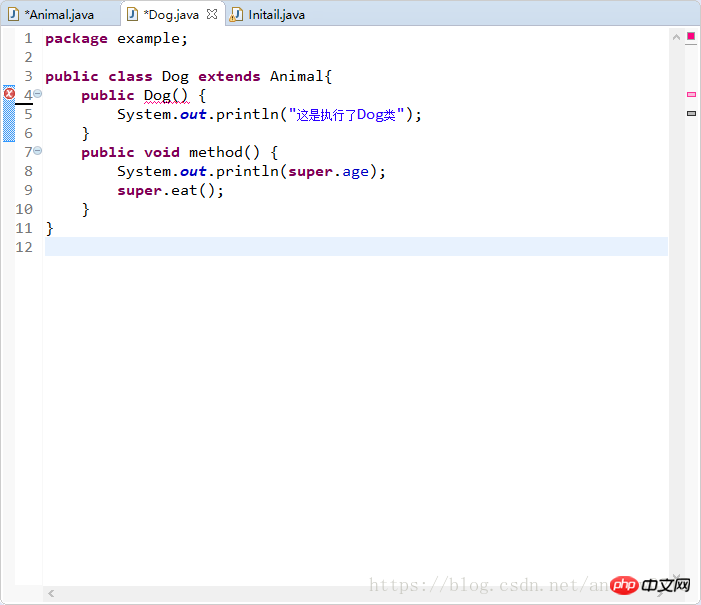
8. Object class: It is the parent class of all classes. If a class does not use the extends keyword to clearly indicate that it inherits another class, then this class inherits the Object class by default.
Methods in the Object class are suitable for all subclasses.
1) toString() method
The hash code of the object returned when defining a toString() method in the Object class (Object address string)
###可以通过重写toString()方法表示出对象的属性。
2)equals()方法
比较的是对象的引用是否指向同一块内存地址。
一般情况下比较两个对象时比较他的值是否一致,所以要进行重写。
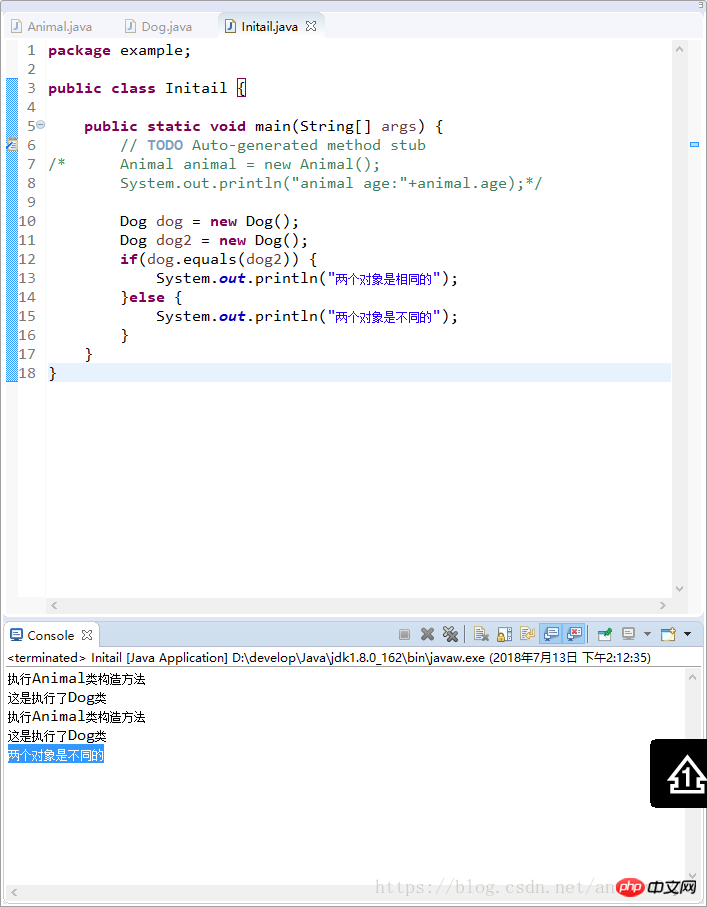
此时若同时给age赋相同值

由此可见还是输出false 在这我们建立equals方法
创建equals方法: Source --> Generate hashCode() and equals()...

@Override
public boolean equals(Object obj) {
if (this == obj)
return true;
if (obj == null)
return false;
if (getClass() != obj.getClass()) //判断两个对象的类型是否相同
return false;
Dog other = (Dog) obj;
if (age != other.age)
return false;
return true;
}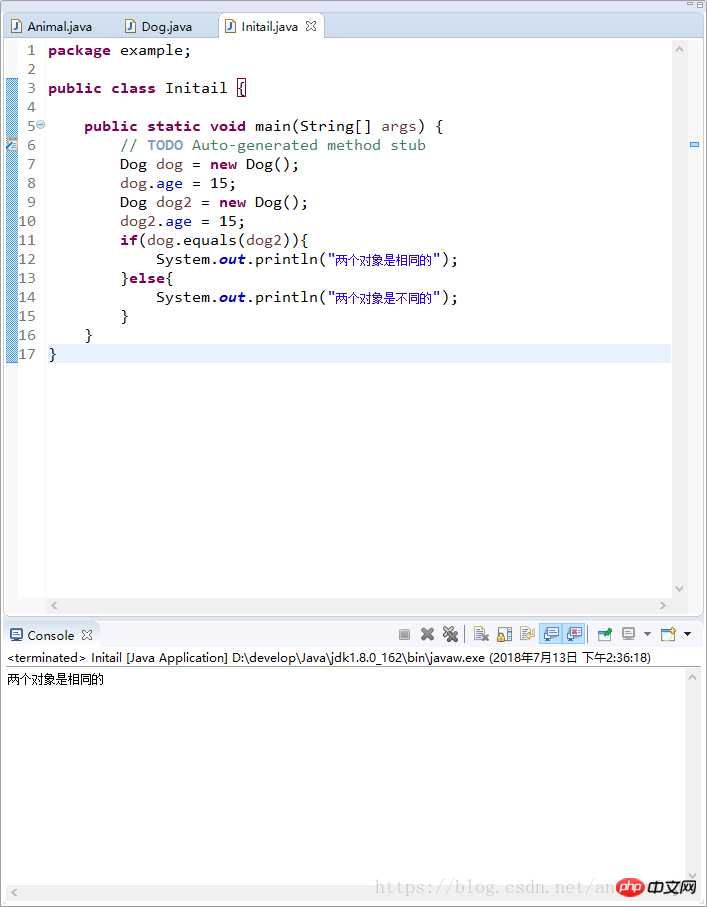
此时结果就为true了
####END####
相关文章:
The above is the detailed content of JAVA introductory system tutorial (8) Object-oriented (inheritance). For more information, please follow other related articles on the PHP Chinese website!

Hot AI Tools

Undresser.AI Undress
AI-powered app for creating realistic nude photos

AI Clothes Remover
Online AI tool for removing clothes from photos.

Undress AI Tool
Undress images for free

Clothoff.io
AI clothes remover

Video Face Swap
Swap faces in any video effortlessly with our completely free AI face swap tool!

Hot Article

Hot Tools

Notepad++7.3.1
Easy-to-use and free code editor

SublimeText3 Chinese version
Chinese version, very easy to use

Zend Studio 13.0.1
Powerful PHP integrated development environment

Dreamweaver CS6
Visual web development tools

SublimeText3 Mac version
God-level code editing software (SublimeText3)

Hot Topics
 1387
1387
 52
52
 Perfect Number in Java
Aug 30, 2024 pm 04:28 PM
Perfect Number in Java
Aug 30, 2024 pm 04:28 PM
Guide to Perfect Number in Java. Here we discuss the Definition, How to check Perfect number in Java?, examples with code implementation.
 Weka in Java
Aug 30, 2024 pm 04:28 PM
Weka in Java
Aug 30, 2024 pm 04:28 PM
Guide to Weka in Java. Here we discuss the Introduction, how to use weka java, the type of platform, and advantages with examples.
 Smith Number in Java
Aug 30, 2024 pm 04:28 PM
Smith Number in Java
Aug 30, 2024 pm 04:28 PM
Guide to Smith Number in Java. Here we discuss the Definition, How to check smith number in Java? example with code implementation.
 Java Spring Interview Questions
Aug 30, 2024 pm 04:29 PM
Java Spring Interview Questions
Aug 30, 2024 pm 04:29 PM
In this article, we have kept the most asked Java Spring Interview Questions with their detailed answers. So that you can crack the interview.
 Break or return from Java 8 stream forEach?
Feb 07, 2025 pm 12:09 PM
Break or return from Java 8 stream forEach?
Feb 07, 2025 pm 12:09 PM
Java 8 introduces the Stream API, providing a powerful and expressive way to process data collections. However, a common question when using Stream is: How to break or return from a forEach operation? Traditional loops allow for early interruption or return, but Stream's forEach method does not directly support this method. This article will explain the reasons and explore alternative methods for implementing premature termination in Stream processing systems. Further reading: Java Stream API improvements Understand Stream forEach The forEach method is a terminal operation that performs one operation on each element in the Stream. Its design intention is
 TimeStamp to Date in Java
Aug 30, 2024 pm 04:28 PM
TimeStamp to Date in Java
Aug 30, 2024 pm 04:28 PM
Guide to TimeStamp to Date in Java. Here we also discuss the introduction and how to convert timestamp to date in java along with examples.
 Java Program to Find the Volume of Capsule
Feb 07, 2025 am 11:37 AM
Java Program to Find the Volume of Capsule
Feb 07, 2025 am 11:37 AM
Capsules are three-dimensional geometric figures, composed of a cylinder and a hemisphere at both ends. The volume of the capsule can be calculated by adding the volume of the cylinder and the volume of the hemisphere at both ends. This tutorial will discuss how to calculate the volume of a given capsule in Java using different methods. Capsule volume formula The formula for capsule volume is as follows: Capsule volume = Cylindrical volume Volume Two hemisphere volume in, r: The radius of the hemisphere. h: The height of the cylinder (excluding the hemisphere). Example 1 enter Radius = 5 units Height = 10 units Output Volume = 1570.8 cubic units explain Calculate volume using formula: Volume = π × r2 × h (4
 Create the Future: Java Programming for Absolute Beginners
Oct 13, 2024 pm 01:32 PM
Create the Future: Java Programming for Absolute Beginners
Oct 13, 2024 pm 01:32 PM
Java is a popular programming language that can be learned by both beginners and experienced developers. This tutorial starts with basic concepts and progresses through advanced topics. After installing the Java Development Kit, you can practice programming by creating a simple "Hello, World!" program. After you understand the code, use the command prompt to compile and run the program, and "Hello, World!" will be output on the console. Learning Java starts your programming journey, and as your mastery deepens, you can create more complex applications.




